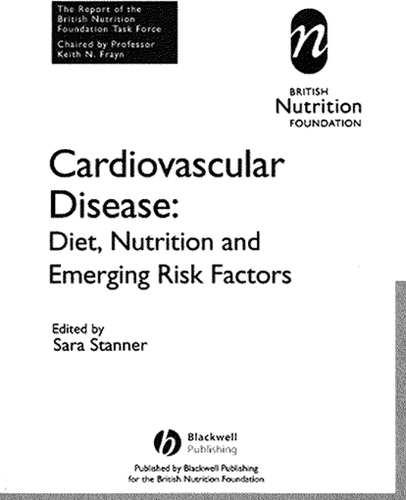Sara Stanner, ed. Oxford: Blackwell; 2005. 400 pp.
ISBN 1405101660. £48
Cardiovascular disease is the leading cause of death worldwide, accounting for about 18 million deaths each year. Around 50% of these deaths are from coronary heart disease and a further 25% from stroke. Classical risk factors for cardiovascular disease include smoking, elevated cholesterol levels, raised blood pressure, physical inactivity, obesity and diabetes. However, these conventional risk factors do not account for all cardiovascular risk and they cannot fully explain gender, ethnic and socioeconomic differences in cardiovascular disease. Furthermore, treatments that are effective in altering conventional risk factors, e.g. statins used to lower cholesterol levels, do not totally remove the risk, but reduce it by one-third or even less.
Against this background there is an ongoing search for other, more subtle indicators of risk of cardiovascular disease, including endothelial dysfunction, oxidative stress, inflammation and the haemostatic system, as well as adipose tissue-derived factors and the clustering of multiple interrelated risk factors known as the metabolic syndrome. Although a lot of information has been gathered about these “novel” risk factors, little is known about how they may be altered to reduce cardiovascular risk and disease. In particular, not much is known about the interplay between diet, nutrition and the novel risk factors. Consequently, the British Nutrition Foundation set up a task force chaired by Keith N Frayn, Professor of Human Metabolism at the University of Oxford, to elucidate the emerging risk factors for cardiovascular disease and their relationship to diet. The present report, “Cardiovascular disease: diet, nutrition and emerging risk factors”, edited by Sara Stanner, is the interesting result of these efforts.
The two initial chapters cover classical epidemiology and aetiology of cardiovascular disease, as well as the metabolic syndrome, obesity and insulin resistance. The following chapters give the reader an abundance of information about lipid-related factors, such as small, dense low-density lipoprotein (LDL) particles and postprandial remnant lipoproteins, endothelial dysfunction, oxidative stress, coagulation and fibronolysis, as well as factors related to low-grade inflammation such as C-reactive protein (CRP), fibrinogen and serum amyloid A. All these novel factors are of importance for understanding the process of atherosclerosis and thrombosis, i.e. the lesions in arterial walls and blood clotting that result in manifest cardiovascular disease and very often in death. Subsequent chapters focus on homocysteine and adipose tissue-derived factors, such as leptin, adiponectin and cytokines, e.g. tumour necrosis factor-à and interleukin-6. In a separate chapter foetal and maternal nutrition and the relationship between low birth weight and adult cardiovascular disease are discussed. All these 10 initial chapters include final key points and recommendations from the task force for future research efforts and, when applicable, a discussion about dietary factors and their influence.
Chapters 11 and 12 summarize the current information about diet, physical activity and cardiovascular disease, including issues being publicly discussed such as glycaemic index, high-protein–low-carbohydrate diets, fish oil supplements and how much (or little) physical activity is required to sustain cardiovascular health. Although not an issue covering many pages in the book, I found the discussion of genetic variation and gene–nutrient interactions especially interesting and of great interest for the future. Although long-chain n-3 fatty acids can reduce cardiovascular events, it has been shown that a proportion of individuals who carry the apolipoprotein E4 (apoE4) allele respond to fish oil supplementation with a 15% increase in LDL-cholesterol levels, compared with individuals homozygous for the apoE3 allele. In the UK, 25–30% of the population carry the apoE3 allele.
The final chapters dwell on the very important public health aspects of cardiovascular risk reduction, as well as recommendations from the task force to policy makers, health professionals, the food industry, employers and the media. Very good features for the journalist are the questions and answers chapter and the glossary.
In conclusion, I find this British Nutrition Foundation report very interesting, well written and structured, and covering an abundance of current knowledge about novel risk factors for cardiovascular disease, and I strongly recommend it. Students and young researchers in particular will find it a most interesting source of information, and more established health-care professionals can definitely update their knowledge. However, the central point of the book is on emerging risk factors and not on diet and nutrition, the subtitle of the book thus being slightly misleading. It seems that much more research is needed before we are able to shift focus.
